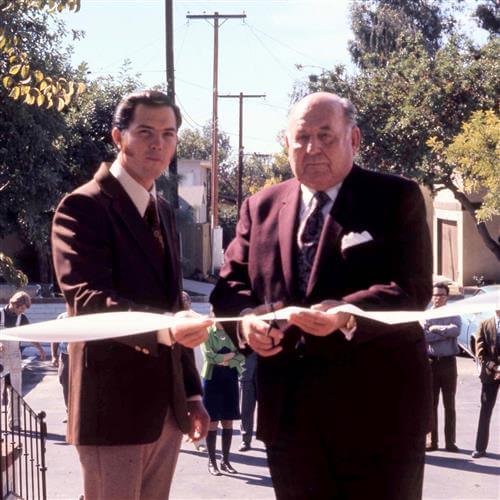Founding Sherman Library & Gardens

Paul Wormser, Library Director
Sherman Library & Gardens’ origins can be traced to one day in April 1914. On that day, Moses Hazeltine Sherman approached Arnold Haskell, a young man working as a clerk at the reception desk of the Mission Inn in Riverside, with a job offer. Years later Haskell recalled, “The General [Sherman] came in and he said, ‘Arnold, do you want to work for me?’ I said, ‘Yes, I do.’ He said, ‘Well, the train leaves for Los Angeles at four o’clock this afternoon.’ Years later, Arnold Haskell would honor the man who hired him by naming Sherman Library & Gardens after him.
In 1914 when Sherman hired Haskell, Sherman was a highly successful and well-known businessman. More than forty years before, as a young man, Sherman had moved to the Arizona Territory to teach school. In the coming years, he would rise in prominence, becoming the first Superintendent of Public Instruction. Later, he was appointed, and then re-elected, Adjutant General of Arizona, in charge of the territorial militia – thus earning the honorary title “General.” He also manifested a talent for finance and investment – in mines and real estate initially. He eventually owned the Phoenix Street Railway, had a controlling interest in the Phoenix Water Company and owned considerable land in Phoenix, even donating the land on which sits the State Capital building. By 1890 he was looking to expand his investments. He chose Los Angeles.
In Los Angeles, Sherman began acquiring street railroads to created the first network of electric street cars, the Los Angeles Consolidated Electric Railway. He then built the first interurban in Southern California, the Los Angeles and Pasadena Railway. While building his railroads and investing in land, Sherman was also making friends. Most prominent among these were Harrison Grey Otis, founder of the Los Angeles Times; Harry Chandler, Otis’s son-in-law and publisher of the Times; Otto F. Brant, a founder of Title Insurance and Trust Company; and Hobart Whitley, sometimes known as the “Father of Hollywood.” In 1909, these men formed the Los Angeles Suburban Homes Company, which acquired 47,500 acres of farmland in the San Fernando Valley and subdivided it following the arrival of water through the Los Angeles Aqueduct, creating Canoga Park, Van Nuys and Encino in the process. In 1912, members of this same group purchased the Tejon Ranch, which encompassed more than 275,000 acres at the top of Tejon Pass.
Thus, when Arnold Haskell signed on with Sherman, he was agreeing to work for one of the most prominent and successful businessmen in Los Angeles. When Sherman hired Haskell, there was no negotiation over salary or responsibilities. Haskell did not know what his duties would be or how much he would be paid. He could not have known that he would stay in the Sherman’s employ for the next eighteen years, becoming his almost constant companion, closest confidant and eventual successor to his business interests.
Haskell became Sherman’s personal secretary, working with him on every aspect of his businesses. In the years that Haskell worked for Sherman, he continued to launch new enterprises. For example, Sherman became one of the founders of the Los Angeles Steamship Company, a passenger line with routes to San Francisco and Honolulu. He also created a partnership that developed Hollywoodland, and subdivided 1,000 acres of his San Fernando Valley holdings to create Sherman Oaks.
Sherman passed away in 1932. The last couple of years of his life, in ill health, he retreated to a home on Bay Island, in Newport Harbor. Sherman’s illness and the effects of the Great Depression left his estate deeply in debt, despite valuable land holdings. In the first few years following Sherman’s death, Arnold Haskell worked with extraordinary tenacity and intelligence as trustee of the estate and president of the M. H. Sherman Company to turn around the investments. Haskell then focused on expanding his real estate portfolio, acquiring prime land in Los Angles, Newport Beach and Dana Point. By 1951, he felt he was successful enough to launch a new career as a philanthropist. With Sherman’s two daughters – Lucy and Hazeltine – Haskell created the Sherman Foundation.
In its first 15 years the Foundation functioned as a grant-making institution, but that would eventually change. In 1955, Haskell moved his business offices from Los Angeles to Corona del Mar after buying a parcel of land at the corner of Coast Highway and Dahlia from Norman’s Nursery. The lot had a small adobe house dating from the late 1930s which Haskell used as an office. In 1956 he added additional office space. Both the adobe and office addition are now occupied by Sherman Library.
Arnold Haskell then started buying more property on the same block. He had to do this quietly to keep the sellers from raising prices. It took him more than a decade to acquire the land that is now Sherman Library & Gardens. Having done so, the Sherman Foundation shifted its focus from grants to creating to creating a research library and public gardens. Planning began in earnest 50 years ago. It was not until 1974 that construction of Sherman Library & Gardens was complete.
So why did Arnold Haskell name Sherman Library & Gardens after his mentor? In 1974, Haskell said:
[Sherman] was a heck of a good teacher, too; he taught me everything I know about business … But one thing the General wanted: he wanted his name to be perpetuated. Now I never cared for that. In 1951, when I founded the Foundation, the attorneys wanted me to call it the Arnold Haskell Foundation, because they felt that, being alive, I could accomplish more with it than if it was named after somebody that nobody knew. But I thought, well, this is the opportunity… to carry on the General's name.
Arnold Haskell Tweet



